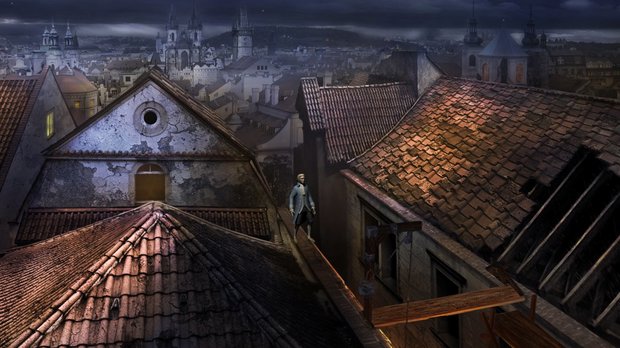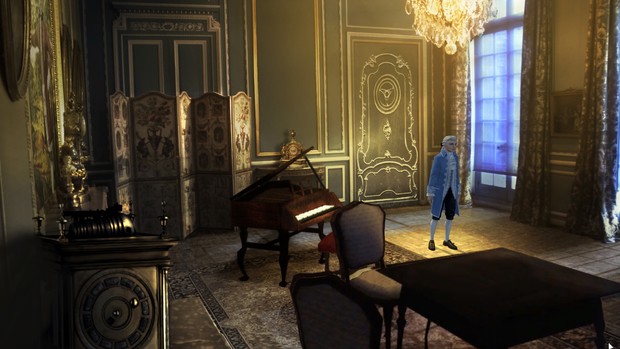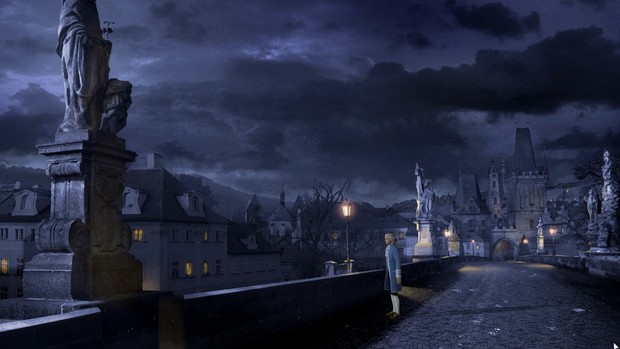Mozart Requiem review

- 1 Comment
Entertaining historical mystery desperately in need of fine tuning
When contemplating the great adventurers throughout history, Wolfgang Amadeus Mozart likely isn’t the first to spring to mind. However, the famed composer stars in Hoplite Research’s 2.5D point-and-click Mozart Requiem and makes a surprisingly capable protagonist, investigating murders, unravelling the hidden conspiracies of secret societies, spelunking through an ancient Egyptian temple hidden under Prague, and romancing the wife of the director of the Opera. Despite some absurd story moments, Mozart’s journey is wonderfully epic. Unfortunately, the game’s laurels abruptly end there, giving way to a litany of problems that should have long been resolved in a game that’s over a decade old and only now arriving in English.
Mozart has travelled to Prague at the behest of Emperor Joseph II. The composer is doing what he does best, making up operatic music, but he is plagued by nightmares that some terrible fate will befall the emperor. Before he can attempt to warn his benefactor of impending doom, however, the challenges facing Mozart start out far more mundane: he needs to get paid for the release of his latest opera Don Giovanni in order to settle his debts with his landlord. From there, over the course of nine or so hours of play time, Mozart’s path leads him all over and under Prague. Things really get rolling when he joins his fellow masons at the local lodge, where a young hopeful named Anton Epoch has composed a musical piece. Mozart is incensed when he recognizes it as a poor copy of one of his own symphonies, but his anger lands him in trouble with the authorities when Anton is murdered.
Mozart manages to escape in order to clear his own name by discovering the killer, setting him on a course of ever more dramatic twists and turns. Along the way, he learns of a plot to depose Joseph II; encounters a rival fraternity, the Rosicrucians; finds himself the uninvited guest of a band of Romani (which the game calls Gypsies); discovers an Egyptian temple hidden beneath the city; and even defuses a bomb. Not bad for an eighteenth-century composer of short stature.
During his travels, Mozart encounters a diverse group of characters. From his Mason brothers to his Rosicrucian enemies, the people he meets are impressed by his musical skills if not his personality. In the case of the opera director, there’s good reason to dislike Mozart as he is having an illicit affair with the man’s wife, who desperately wants a singing role in the composer’s next opera. Then there’s the Romani who may decide to help or hinder Mozart. One of their number even becomes a playable character for a short duration.

I found myself drawn into Mozart’s story. He’s a pleasant character, and the scope of his journey is impressive. This was a game that I wanted to keep playing to see what happened next, even when some of those events were a little on the wacky side. At one point Mozart is captured by the Romani, who accuse him of being an agent of their sworn enemy, the Rosicrucians. To demonstrate his innocence, Mozart must … beat his captors at a game of Blackjack. Doing so proves he is so just and virtuous that they proclaim they’d make him king if they were back home. Okay, sure. Fortunately these lapses in story logic are infrequent.
Less easy to overlook are the constant reminders that Mozart Requiem is not a finished product. It’s not simply a matter of having a few bugs or lacking polish. Rather, everything from the interface, to mechanics, to some visuals, to dialog and subtitles falls short of being acceptable. This is particularly damning given that the game was originally released way back in 2008 in a Dutch edition called Mozart: Conspirators of Prague and a French version called Mozart: The Last Secret.
The translation into English is a major reason why this rerelease feels like it was rushed out the door. The voice quality is actually quite good; the problem is the recorded audio rarely matches the subtitles, which are theoretically optional but in practice need to be turned on. Mostly the discrepancies are down to differences in wording, but there are a handful of times when what a character tells you to do in the audio is wrong while the subtitles are right. With frequent use of modern-day slang and nearly every line riddled with spelling and grammatical mistakes, reading/listening to the dialog is always jarring.
The problems don’t end with the localization, though. Numerous issues with interactive areas are evident right from the first scene. Most times mousing over hotspots changes the pointer and displays a text label. However, this does not always happen, with some points of interaction providing no feedback at all. And on the topic of no feedback, many hotspots provide none when clicked on. If you’re lucky, Mozart may at least walk towards it, but only by using a suitable inventory item will he do anything. Hopefully. There are several instances where nothing is done, period. Mozart doesn’t animate or say anything, no sound effects play, and nothing visually changes on-screen. The only way to know that something changed is to check the inventory and see that the used item is gone.

Even finding hotspots can be tricky. The game provides no object highlighter, so the dreaded issue of crucial items blending into the background shows up from time to time. Worse, however, is when the interactive areas of a room do not align with what is depicted in the scene. In one instance, Mozart encounters a rather sizable dog lying on the floor. However, for me the hotspot was not on the dog itself but over half a screen away and almost on the ceiling. Alignment issues don’t end there, either; in numerous instances, leaving one room will place Mozart next to a door in the next room, but that’s not the door that needs to be used to get back to his starting location.
Much of the gameplay involves inventory puzzles. Most of these are solved simply by selecting an item from the inventory and using it on a hotspot in the room. However, some of these require combining items in the inventory first. Usually this is as simple as using item A on item B or vice versa. However, there are instances where players must use item A on item B, as attempting to combine them the other way around does not work.
Indeed, Mozart Requiem was clearly developed with the notion that actions would be performed in a specific order. This occasionally causes game-stopping problems if the order is reversed. I discovered a secret room with a man in it. The intended sequence in this room is to talk to the man first to trigger a cutscene of two other gentlemen arriving, from whom Mozart has to hide. However, when I explored this location I combined a couple of items first, which played a cinematic of the visitors already in the room when I had yet to see the scene of their arrival. Afterward, when I finally talked to the man, the earlier cutscene played anyway and left the game in a state where Mozart thought he needed to hide, but the items to do so were no longer available. My only recourse was to reload the game. Fortunately the game has a manual save system, and given the many issues I’d already encountered, I’d taken to the old maxim of save early, save often.
Visually, the game is a mixed bag. In deference to modern standards, most rooms have been remastered to high resolution. The ones that have look quite good, including the cavernous opera house, the hidden temple, and a majestic bridge. The few that haven’t stand out like sore thumbs with their blocky, blurry images. Character models are what would be expected from a 2008 game instead of 2022. They’re nothing fancy and get the job done, other than when they occasionally appear in places where they shouldn’t. I must admit, I got a good chuckle at Mozart’s rebellious nature when walking all over a piano that he was clearly meant to appear behind. Actually, “walking” isn’t the correct word as Mozart’s walk animation isn’t in sync with the amount of ground he covers, which makes him look more like he’s skating through his surroundings than integrating with them.
Aside from the game’s very rough state, there are a few things that distinguish Mozart Requiem from other point-and-click adventures. As befits its famous namesake composer, there are several music-related minigames throughout. In some instances, Mozart will find a musical score that he has to correct. Sheet music is displayed on-screen with multiple short sequences of notes highlighted in red or blue, which have to be swapped on the page to correct the melody. The trick is, only a finite number of incorrect swaps can be made before the puzzle fails, which resets it to the beginning to try again. A good ear is not required, but as a self-proclaimed musical illiterate, I had to attempt most of these multiple times, especially in the later stages when the musical compositions have far more notes that need to be shifted around. Even so, I was able to recognize enough patterns to make a good stab at these.
After correcting the musical compositions, Mozart usually has to conduct them as well. This is done in a close-up first-person view displaying a conductor’s baton. A circle moves in different directions on the screen and players must drag the mouse to keep the tip of the baton inside it in order to deliver a good performance. It’s fine to fall out of the circle for a short duration, but straying too long causes the performance to fail. Again this simply means starting over and trying again.
The most successful specialty puzzle is in a book of codes that a friend sends to Mozart. With these, a grid is displayed with some of the squares filled in with letters and some left blank. A hint is given to get you started on finding a hidden word or phrase in the letters, such as “The Symbol of the Apprentices...” You must then remove an indicated number of letters, such that the remaining ones spell the desired answer. I quite enjoyed these, although this too created problems when some of the resultant answers would give incorrect information for what other parts of the game world required.
No discussion of a game about Mozart would be complete without mention of the score itself, and playing throughout is orchestral music by the maestro himself, all classically arranged. With as many works as Mozart composed, there was no trouble choosing selections that matched the events occurring within the game. From the lighter pieces when Mozart is just spending time in his room to the darker, more ominous compositions when things take a nasty turn, the accompaniment is always spot on.
Final Verdict
It’s hard to sum up Mozart Requiem. At every turn it hammers home its incompleteness. I’ve played Early Access games in a far more polished state than this. The localization is in desperate need of an editor. Hotspot interactions, feedback, and even placement need to be corrected. Allowing for actions to be done in different orders is a definite must. And a good round of bug squashing would not go amiss. And yet … and yet … I walked away having somewhat enjoyed myself. Call it a guilty pleasure, but this fictionalized life of Mozart as some sort of secret agent is strangely compelling, even when the story logic is way out there. Many of the problems could be corrected or at least mitigated with another month or two of development, which is hard to imagine happening at this point. Unless it does, I can’t in good conscience recommend this to anyone on its merits as a complete adventure. For all of that, I was reasonably entertained when it worked as it should, and can only imagine how awesome it might have been had it been updated properly after so many years of waiting.
Hot take
Finally localized in English after being released in Dutch and French over a decade ago, Mozart Requiem is so unpolished it’s still not ready for prime time release, seriously undermining its fine protagonist and a story full of intrigue and adventure.
Pros
- Intriguing story of secret societies, conspiracies, lost civilizations, and music
- Mozart is a fine adventurer
- Some interesting melody-based puzzles
- Excellent musical pieces composed by Mozart himself
Cons
- Too many examples of both non-interactive and non-visible hotspots
- Misaligned room entrances and exits
- Doing things in the wrong order can leave the game unwinnable
- Occasional visual glitches and some rooms haven’t been remastered
- Poor, even misleading subtitle editing










1 Comment
Want to join the discussion? Leave a comment as guest, sign in or register.
Thank you for this excellent write-up AND for clarifying the difference between Requiem, Conspirators of Prague, and The Last Secret. So many websites and/or reviews refused to explain this, or shed some history on this IP. I was wondering why the previous two weren't available on STEAM/GOG. Now, I don't need to beg the publishers to port the older game, haha. I know the game has poor quality translation/subtitles, but for $1.94 (currently), I guess I'll bite the bullet.
Reply
Leave a comment